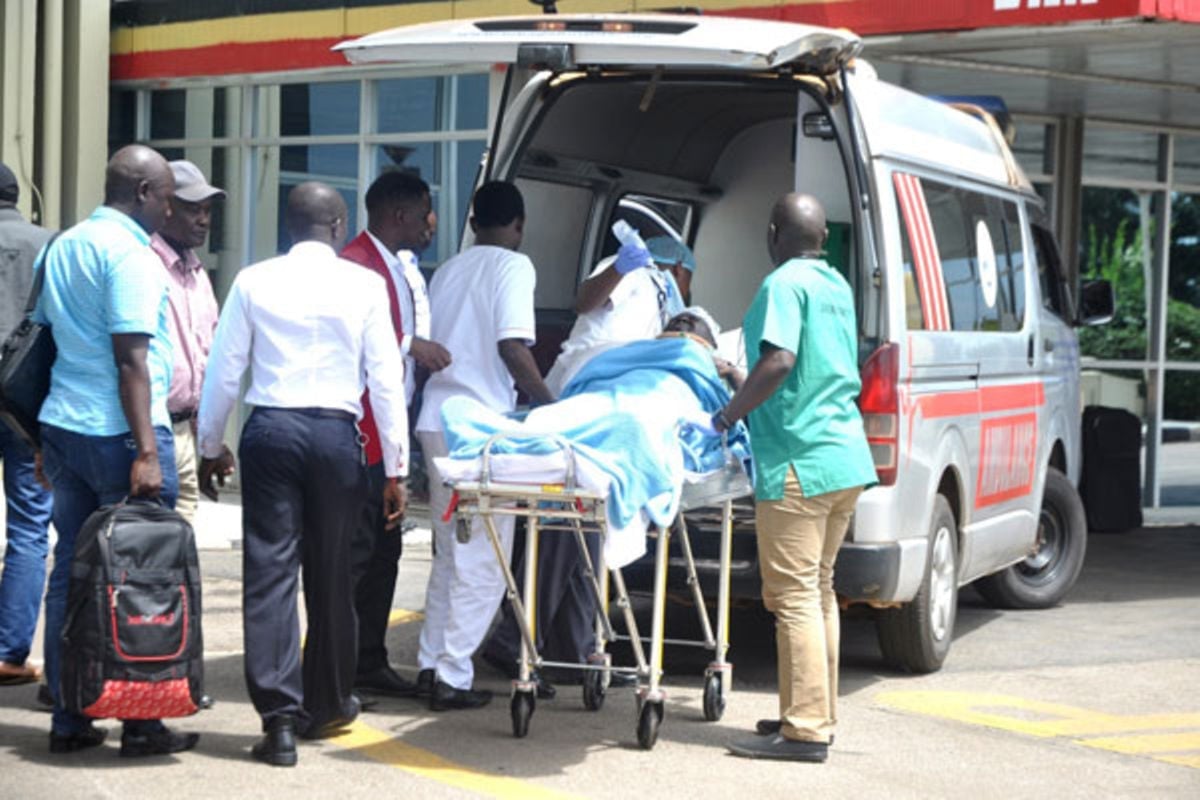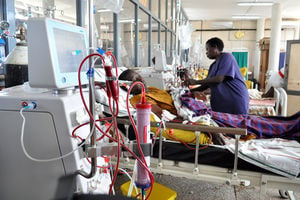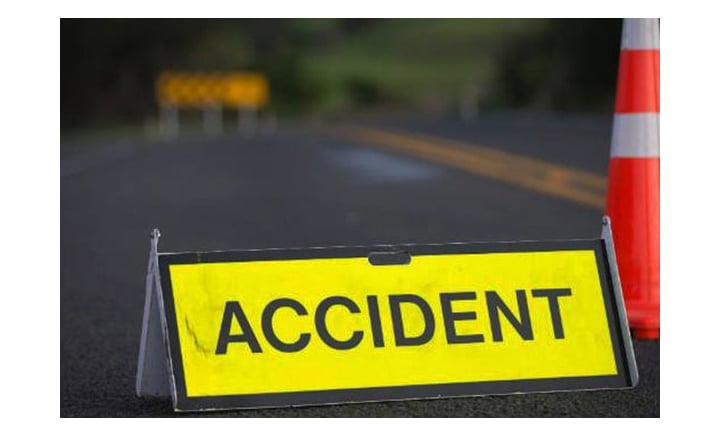
Doctors take a patient out of an ambulance at the hospital. Such services require upfront payment. PHOTO/FILE
At least 38,996 deaths were registered in emergency care units across the country between July 2023 and June 2024.
The deaths mainly occur because patients are unable raise upfront fees and in some instances for lack of consultation money.
A new health sector performance report shows the deaths happened amid declining utilisation of ambulances and gaps in care. The new performance report released on October 23 indicates that Karamoja and Ankole have the highest proportion of emergency patients evacuated by ambulance, at more than 17 percent, while South-Buganda and Kampala have a very low utilisation at four percent, indicating disparities.
The report, besides showing the disparities, also reveals that ambulance utilisation in the country has declined by about five percentage points within five years. This raises questions about the effectiveness of the government’s emergency medical services.
The report shows there were 38,996 deaths registered among patients handled in emergency units across the country in the 2023/2024 financial year.
“The National Average Ambulance utilisation was 7.5 percent. Karamoja had the highest proportion of emergency patients evacuated by ambulance at 18.9 percent followed by Ankole (17.3 percent), Bugisu (14.7 percent), and West Nile (13.4 percent). On the other hand, South-Central reported the lowest utilisation of ambulance services at 3.9 percent,” the report reads.
“The decline in emergency patients arriving at health facilities by ambulance over the past five years highlights gaps in reporting from the different departments in health facilities and resource constraints like limited fuel and staffing,” the report reads further.
The report authors at the ministry recommended that addressing these gaps requires “better inter-programme collaboration, standardised reporting, staff training, and improved monitoring to accurately capture ambulance service utilisation and enhance emergency care delivery.” However, health facilities in Lango Sub-region had the highest number of deaths in their emergency units at 40 percent of the patients, signalling gaps in care. Lango had an ambulance evacuation rate of six percent, which was better than South-Buganda, Kampala and other four sub-regions.
"We need to investigate that. It may be a reporting issue, because 40 percent is on a high side," Dr John Baptist Waniaye, the commissioner for Emergency Medical Services at the Ministry of Health, said.
Ankole, in terms of deaths in the emergency units, followed Lango at 19.7 percent, while Tooro stood 16 percent, South-Central 11 percent, and West Nile, Acholi and Kigezi had the lowest death rates at about four percent of the patients.
The variations here seem to indicate that although access to an ambulance is a contributor to good medical outcome, accessing it may not be a guarantee that one will get quality emergency care when one reaches the hospital.
Dr Waniaye added that they are still trying to understand the exact reason behind the variations in the utilisation of ambulances across sub-regions.
He, however, believes the variations among sub-regions could result from the differences in population density, the responsiveness of health workers, support from donors, the willingness of communities to use ambulances and the reporting by health facilities.
“South-Buganda has more ambulances but it is densely populated. In a densely populated community, the number of emergencies is higher than in a sparsely populated community,” he explained.
“So, many people in densely populated communities may not be able to get the services but we are going to interrogate that so that we see why South-Central, which has had more investment in terms of emergency medical services, is reporting less response,” he added.
Dr Waniaye also said because of insecurity in Karamoja, the likelihood of calling for an ambulance by the community is higher than in areas with less insecurity. But this argument may not stand for the good performance of Ankole, which has few insecurity issues when compared to Karamoja.
“In Karamoja, health workers seem to be more responsive to the community compared to other places. But generally, if the reporting [on ambulance utilisation by health facilities] increases overall, we are going to see a different picture,” he argues.
“But we have some regions that have extra support from development partners that is why you see differences in performance,” he adds.
Funding gaps
Dr Waniaye also revealed that they are facing inadequacies in funding.
“This is a very big problem. We require about Shs17 billion for our operations – in terms of fuel, repairs and other things for ambulances,” he said.
“But right now, we are running at an average of Shs5 billion – that is like 25 percent of our needs are covered and this leaves a big gap,” he added.
Leading areas in emergencies
The performance report shows that Kampala reported the highest number of emergency cases, followed by South-Central, Acholi, Busoga, and West Nile. In contrast, Teso reported the lowest number of emergency cases during the 2023/2024 financial year.
“On average, 54.8 percent of all emergency cases received care at the scene of the emergency, and only 7.4 percent arrived at health facilities using ambulance services. Among these, 80.8 percent accessed care within one hour of arrival at the emergency units, with a case fatality rate of 10.2 percent recorded within the emergency units,” the report reads further.
The country, according to information from the ministry, under the national ambulance service, there are 276 ambulances. These are the ones certified as standard ambulances. This falls short of the ministry’s need of at least 460 standard ambulances to curb preventable deaths from emergencies.
The available standard ambulances are also below the minimum requirement of at least one ambulance per constituency, each having an average of 120,000 people. There are 353 constituencies in the country, according to the Electoral Commission. But Dr Waniaye says there are other ambulances, that are helping communities but are “not standard and they number around 178.”
During emergencies, people use a range of means, including ambulances, private vehicles, bicycles, boda boda, taxis and foot. Some patients, especially accident victims, are brought to the hospital by police pick-up trucks.
This practice has been challenged by Mulago hospital doctors, who say some patients reach when they have more injuries and are at risk of exposure to HIV due to sharp edges in the cabins and piling up the patients.
Money is your saviour
Amid the limited number of standard ambulances in the country and limited funding for operations, some health workers and drivers are reportedly taking advantage of the patients.
In a recent study report by researchers from Johns Hopkins University and Makerere University, titled, “Dying due to poverty and lack of easy transport,” patients are sometimes asked to make upfront payments for transportation and care.
“While some ambulance services were apparently free, in most cases patients or their relatives had to pay for transportation, with the cost ranging between Shs500,000 and Shs750,000, that is to say, about $135 to $202,” reads the pre-print report published in 2019 by Research Square.
Some ambulance drivers have also been reported as found using the vehicles to carry food items and doing personal work instead of transporting the patients in need.
Mr Dunstan Kasango told this publication he lost his sister, Ms Angel Nakasango, who passed away in June 18, 2021, at the premises of a major hospital after she failed to get emergency care because the family couldn’t raise upfront Shs2m payment for treatment.
The researchers say distance to the health facility, condition of the patient, and vehicle type dictated the transportation cost. There are three types of ambulances –A, B and C.
Type A ambulances are basically a patient carrier with no medical equipment, and type B ambulances are equipped with various medical equipment such as diagnostic equipment, cardio-pulmonary support equipment, monitors, suction machines, and so on. Type C ambulances are intensive care unit ambulances, which have advanced life support equipment.
“Across the country, we need 460 ambulances. We are going to phase out type A ambulances. The plan is that every 100,000 people should have one type B ambulance and each two million people should have one type C,” Dr Waniaye reveals.
The report by the two universities say, even after arriving at a health facility, there may be delays in receiving treatment.
“Some of the reasons for this delay are related to improper communication, limited human resources, or lack of medical supplies. The hospital emergency staff would continue triage and treatment on ambulance trolleys because of an insufficient number of hospital beds. Sometimes ambulances inform private hospitals about patient transfer,” the report reads further.
Private hospitals, charge somewhere between Shs2m to Shs5m daily for managing a severely sick patient in ICU, starting with a Shs10m initial down payment. Failure to raise the down payment may mean a patient will not access care and so die.







